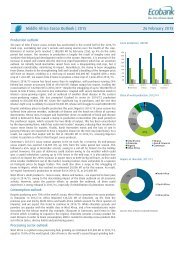www.ebook777.com
Make_Getting_Started_with_Processing_Second_Edition
Make_Getting_Started_with_Processing_Second_Edition
You also want an ePaper? Increase the reach of your titles
YUMPU automatically turns print PDFs into web optimized ePapers that Google loves.
176 Getting Started with Processing<br />
<strong>www</strong>.<strong>ebook777.com</strong><br />
with the films of another director? Will all of this be easier to<br />
read with a different font, sketch size, or aspect ratio? The skills<br />
introduced in the earlier chapters in this book can be applied to<br />
bring this sketch to the next step of refinement.<br />
Network Data and APIs<br />
Public access to massive quantities of data collected by governments,<br />
corporations, organizations, and individuals is changing<br />
our culture, from the way we socialize to how we think about<br />
intangible ideas like privacy. This data is most often accessed<br />
through software structures called APIs.<br />
The acronym API is mysterious and its meaning—application<br />
programming interface—isn’t much clearer. However, APIs are<br />
essential for working with data and they aren’t necessarily difficult<br />
to understand. Essentially, they are requests for data made<br />
to a service. When data sets are huge, it’s not practical or<br />
desired to copy the entirety of the data; an API allows a programmer<br />
to request only the trickle of data that is relevant from<br />
a massive sea.<br />
This concept can be more clearly illustrated with a hypothetical<br />
example. Let’s assume there’s an organization that maintains a<br />
database of temperature ranges for every city within a country.<br />
The API for this data set allows a programmer to request the<br />
high and low temperatures for any city during the month of<br />
October in 1972. In order to access this data, the request must<br />
be made through a specific line or lines of code, in the format<br />
mandated by the data service.<br />
Some APIs are entirely public, but many require authentication,<br />
which is typically a unique user ID or key so the data service can<br />
keep track of its users. Most APIs have rules about how many, or<br />
how frequently requests can be made. For instance, it might be<br />
possible to make only 1,000 requests per month, or no more<br />
than one request per second.<br />
Processing can request data over the Internet when the computer<br />
running the program is online. CSV, TSV, JSON, and XML<br />
files can be loaded using the corresponding load function with a



